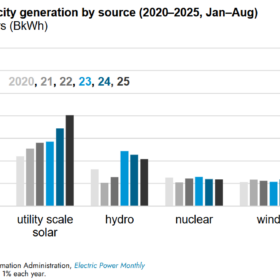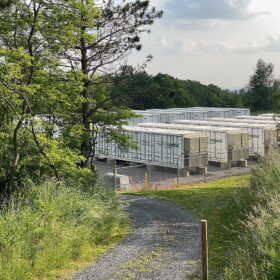An earlier article assessed the significant capital efficiency and carbon advantages of thin-film PV over c-Si. We’ve also explored the malaise plaguing thin-film PV manufacturing.
Although the manufacturing malaise endures — there have been significant developments worth analyzing.
At approximately 33%, the theoretical efficiency limits for crystalline silicon (c-Si), cadmium telluride (CdTe) and copper indium gallium selenide (CIGS) photovoltaic materials are roughly identical — and given the extensive history of c-Si research and manufacturing, it comes at no surprise that silicon’s record device efficiency of 26.7% has narrowed the gap between theory and demonstrated more than CdTe and CIGS.
The official CdTe record device efficiency of 21% for a 1 cm2 R&D cell from First Solar’s lab—as documented in the solar cell efficiency tables published in Progress in Photovoltaics — has not improved since v45 of the tables were published in October of 2014. Subsequently, First Solar was able to leverage the acquisition of the GE IP for a “notable exception,” a R&D device of just 0.3 cm2 at 21.5% (v46 of the efficiency tables, data as of May 2015) and one year later in May of 2016 (v48) demonstrated a “notable exception” at 22.1% (0.48 cm2).
In contrast to the six-year stagnation at the ≥ 1 cm2 device level for CdTe, CIGS has made continuous progress, currently at 23.35% through a two-step processing by Solar Frontier.
The significance of laboratory records demonstrates a technology’s potential, but ultimately the performance of PV modules and associated manufacturing costs determine financial viability. Due to scaling effects — mainly series resistance losses—the absolute delta between record device efficiency and average module efficiency is at the order of 3%, the gap between record R&D devices and champion modules tends to be ≈ 2%. With average Series 6 modules and a champion at ≈ 18% and 19%, respectively, First Solar’s CdTe fits the bill — similar to c-Si.
Monolithically interconnected CIGS on glass, on the other hand, suffers from much wider gaps, at ≈ 8.5% and ≈ 4%, respectively, the deltas are approximately 2x larger than for CdTe and c-Si. This is due to a lack of manufacturing execution expertise, and difficulties scaling a two-step CIGS process to larger areas.
Bifacial thin-film? Tandem?
At this point it may appear that trouble lies ahead for thin-film PV. The efficiency stagnation of First Solar’s CdTe technology is worrisome.
To add to this, during the Q2’20 earnings call, First Solar reported a delay of its CuRe efforts — replacing Cu via Group V doping (As, Sb). First results are now expected for H2’21 and fleet wide implementation during 2022.
No public announcements have been made as to the efforts towards bifacial modules. Since the back contact is the Achilles’ heel of CdTe, no rapid breakthrough towards a transparent back contact is to be expected. Unfortunately, the latter is also a prerequisite for other R&D efforts undertaken by First Solar, namely c-Si/CdTe and CdTe/perovskite tandem devices.
While there are further economic and technical hurdles for tandem technologies, in particular with perovskites, a bifacial CdTe technology would be highly desirable for First Solar for two reasons: First Solar’s dependence on the U.S. utility scale market, and the uncertain future of the section 201 protections including the exemption for bifacial c-Si modules. (As with c-Si, a bifacial CdTe module would have no value in rooftop applications.)
First Solar’s technology path?
Irrespective of the above, in light of the continued advances in c-Si PV manufacturing cost reductions — even more critical by the time section 201 expires — First Solar has to identify a technology pathway that is economically viable and globally competitive.
A manufacturing cost analysis of Series 6 made in Vietnam and Malaysia indicates current COGS in the mid– to upper-20¢/W range. An assessment of cost reduction potential to reach 15¢/W results in the following:
- Given the already exceptional manufacturing execution, gains in yield and equipment uptime at best amount to sub-penny per Watt savings.
- Reducing capex by 50% saves no more than 5%.
- A 50% reduction in material costs equates to ≈ 20% lower COGS.
- At an approx. 25% saving, increasing average module efficiency to 23.5% is the biggest lever.
But as stated above, a 23.5% average manufacturing efficiency would require a champion device of 26.5%. Given the stagnation in record efficiency for the past 6 years there is little confidence that a 5.5% gain can be accomplished in the coming 2 to 3 years. And unlike 2013, there is at present no IP acquisition that may enable such a leap. However, based on theoretical computations the CuRe efforts should enable incremental efficiency improvements.
The CIGS two-step
If we contrast the manufacturing cost analysis for a two-step CIGS technology, in this case Avancis’ efforts in China. Starting at a higher cost compared to First Solar Series 6, and appling the same cost reduction categories yields:
- Improving yield and equipment availability to present First Solar levels results in ≈ 5% cost reduction
- Improving capex efficiency by 50% shaves ≈ 10% of the COGS
- A 50% reduction in material costs equates to less that 10% savings
- Scaling the substrate from the current 1 m2 to 1.8 m2 buys ≈ 20%
- In order to then meet the ¢15/W target an average module efficiency of 20% is required.
With the record 2-step CIGS efficiency at 23.4% and applying the 3% delta it is evident that this is perfectly reasonable with today’s state-of-the-art CIGS technology.
To take the analysis one step further, if the module area were scaled to 2.4 m2 (i.e. matching First Solar’s Series 6) the resulting COGS for Avancis’ CIGS at 20% would be ¢13/W—compared to ¢15/W for CdTe at 23.5%. The numbers are even more favorable for co-evaporated CIGS, but at present there are no meaningful commercial activities in this space.
Back to CIGS
First Solar must have run similar analyses and, just as in 2008, concluded that co-evaporation of CIGS is the superior thin-film technology.
While First Solar has gambled away eight valuable years the company not only has a treasure trove of data from its earlier program, but has acquired key IP assets from a recently defunct Silicon Valley CIGS company and can leverage an extremely capable equipment vendor base.
In light of all this, it makes perfect sense for First Solar to dedicate resources towards co-evaporated CIGS as a parallel technology. One would hope that this time around First Solar sees it through and does not stop prematurely as in 2011.
Co-evaporation of CIGS is not a technical risk, the roadmap and supply chain exist, and the high degree of automation reduces manufacturing location related cost sensitivity. Now would be the time to build a team and enable a ‘Second Solar’ made in the U.S. rivaling First Solar.
***
Markus Beck is a thin-film solar expert and a business and technology consultant who has served as the chief technologist of Siva Power and chief scientist of the CIGS effort at First Solar.
The views and opinions expressed in this article are the author’s own, and do not necessarily reflect those held by pv magazine.
This content is protected by copyright and may not be reused. If you want to cooperate with us and would like to reuse some of our content, please contact: editors@pv-magazine.com.







By submitting this form you agree to pv magazine using your data for the purposes of publishing your comment.
Your personal data will only be disclosed or otherwise transmitted to third parties for the purposes of spam filtering or if this is necessary for technical maintenance of the website. Any other transfer to third parties will not take place unless this is justified on the basis of applicable data protection regulations or if pv magazine is legally obliged to do so.
You may revoke this consent at any time with effect for the future, in which case your personal data will be deleted immediately. Otherwise, your data will be deleted if pv magazine has processed your request or the purpose of data storage is fulfilled.
Further information on data privacy can be found in our Data Protection Policy.